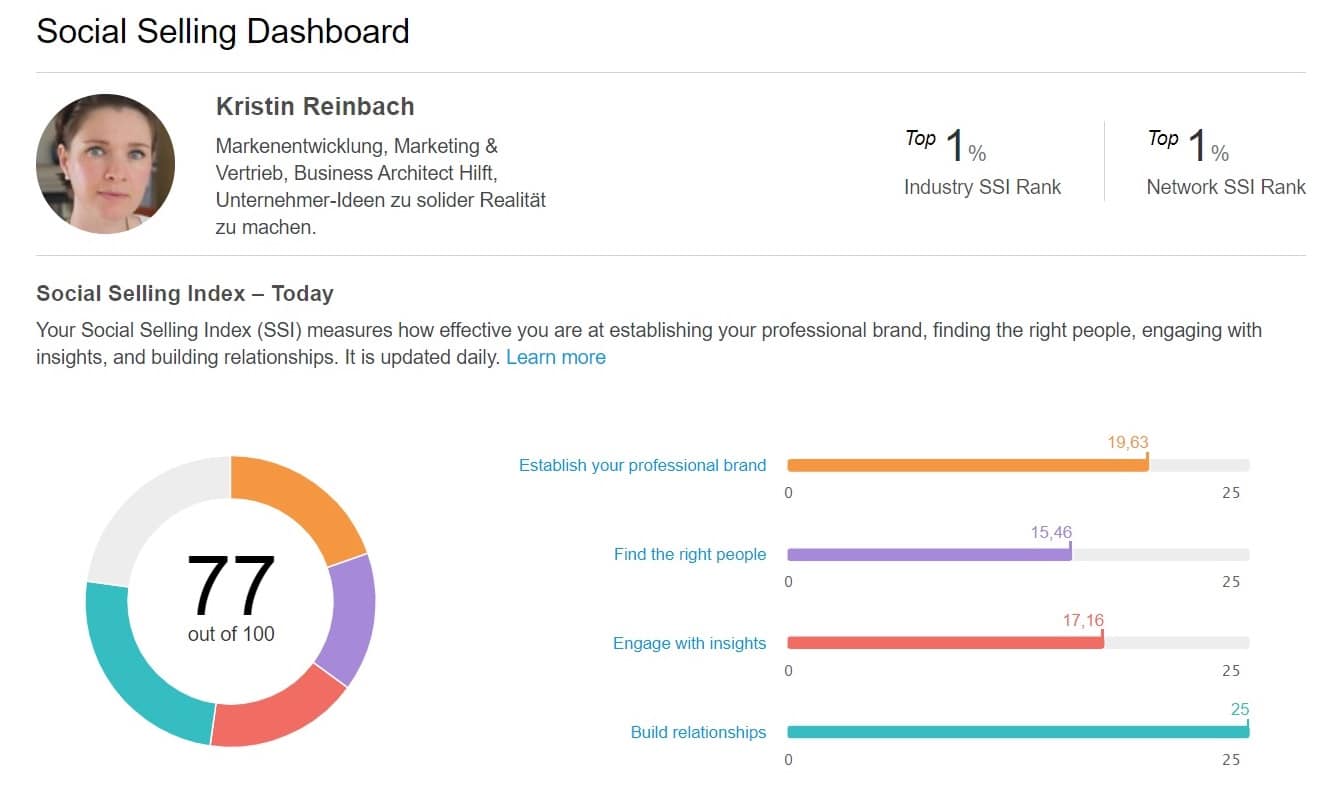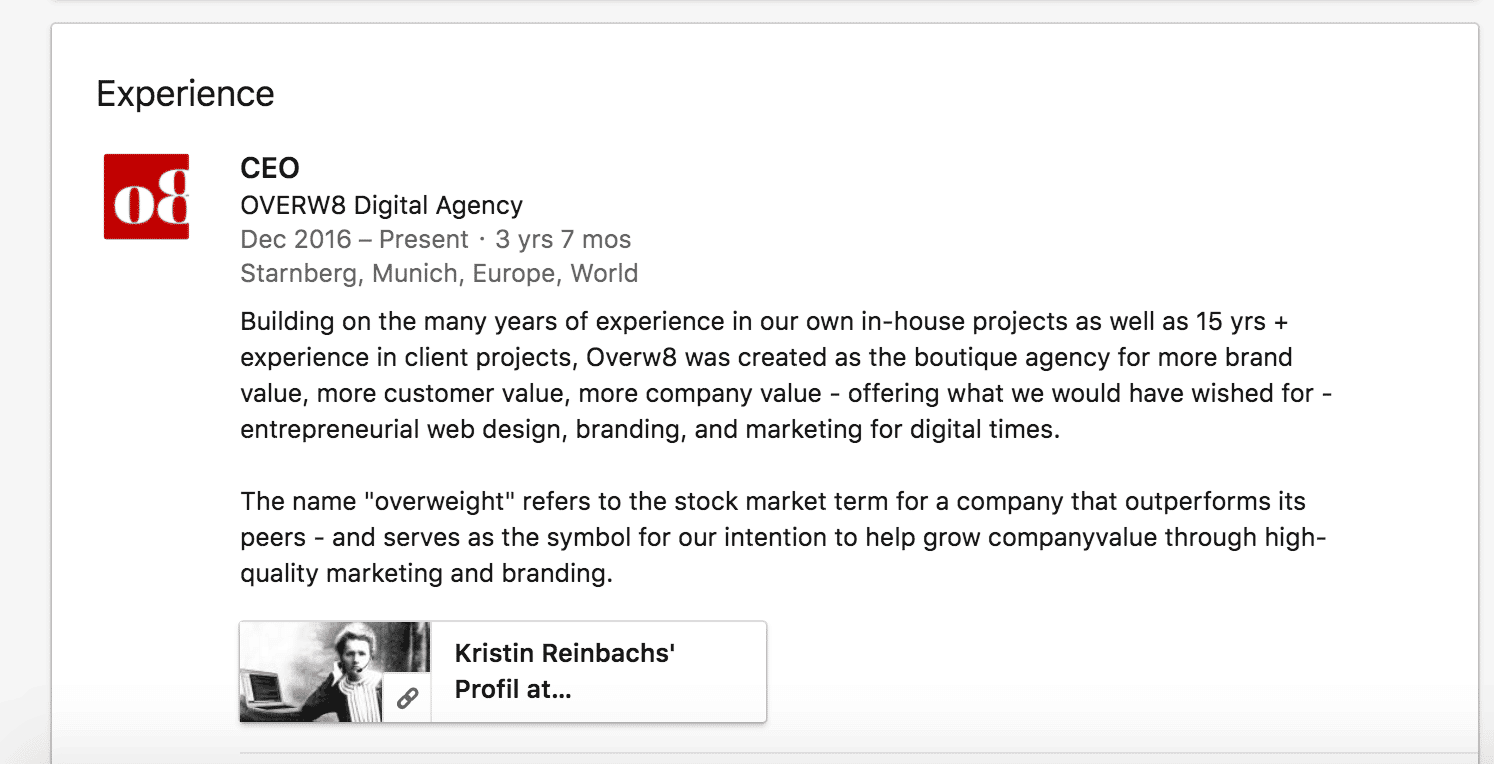Make LinkedIn profiles fit for Social Selling: Here’s how to do it in 3 steps
LinkedIn was associated a few years ago as a “formal job network” where you put your resume. Honestly – it’s more international than Xing, but who thought of trying to optimize their LinkedIn profile? Let alone Social Selling?
LinkedIn has caught up firmly and is giving the previous top dog in the DACH region, Xing, a run for its money. And that’s not necessarily because of user numbers. But because:
Position yourself with the Social Selling Index (SSI) on LinkedIn
The Social Selling Index (SSI) is an assessment tool from LinkedIn which offers a comparison of your profile with a) others in your industry and b) other profiles from your network and displays a value between 0 and 100. In every profile, some things are improvable, and the SSI will tell you. You can find your SSI here.
What is the SSI composed of?
The connection between brand and sales is something our CEO Kristin Reinbach repeatedly explains to many of our customers. A strong brand is the foundation for good sales. The building blocks of the SSI also alligns with this thesis.
The SSI consists of four areas:
- Brand building (orange),
- Network expansion (purple),
- Arouse interest through good content (red) and
- Build relationships (green).
How to rank in the top 3% of your industry (SSI)
Kristin Reinbach’s SSI now has a top score indeed (even in the top 1% each time! Tada!), but achieving better is still possible. We as an agency will naturally stay tuned to contribute further on LinkedIn, find a fair exchange, and hopefully top the value here.
Step 1 – Lay the foundation: Optimize your personal LinkedIn profile for sales
In the same way, we started with the profile of our CEO Kristin Reinbach. Certainly, we can’t always do everything perfectly either. Still, overall it shows that we have already achieved a top result (SSI) with it and can modestly and joyfully stat: “That’s a nice number, even nicer is that we now also get active leads through it!” Say:
The first impression consists mainly of your profile picture and the profile slogan below.
Other cornerstones of your personal profile are:
- Your profile URL
- Your wallpaper
- Your so-called summary aka mini-pitch
- Work experience
- Recommendations
Here are our practical tips based on examples from the profile of our CEO Kristin Reinbach:
Make your own profile URL better readable
You may have noticed that your public profile URL has a combination of numbers and your name. Strike out the excessive numbers, and it will look more appealing.
If your name happens to appear more often, you can think about personalizing the link a bit more, e.g., by adding the professional section “markus-mueller-brand-development.”
Appealing profile photo
An appealing profile picture simply shows you are authentic, friendly, and open to new contacts. Best photographed professionally (or looking professional ;)).
CEO Tips from Kristin on this:
Not so nice:
- Image detail: Too close (being able to see pores in the nose, standing too close to someone) or too far (being photographed from a distance with the Porsche)
- Image content:
Yes, this is all about you. Not the car, horse, garden, husband/wife, etc. / Sounds strange? Right. But I’ve seen it all! - Colors/Light: Not too bright, not too gloomy. No black background.
- Perspective: Neither looking down on the viewer from above nor ‘looking up’ from below.
- Too little or absurd clothing / cramped “I am so different” symbols like hats, colorful bow ties, etc. Except: you have that bow tie on all the time, and it’s your thing.
Much better:
- Just imagine you are at a networking meeting. How would you perform there? The image should do the same job, basically.
- Friendly face
- Rather sideways, dynamic
- Good contrasts, high resolution
Wallpaper
The background image also contributes to the first impression customers get BEFORE they even start reading your profile. An excellent opportunity for some more branding: a background that shows your company (logo, slogan, etc.) would be appropriate here, for example.
Profile slogan
Yes, I know that not everyone’s strength lies in successful communication. “Go digital when massages don’t work.” is a cringe negative example that Kristin ran across the other day. Not so clumsy, please! It’s worth thinking about your profile slogan three times instead and just reading it out loud to yourself over and over again.
Simple test:
CEO Tip from Kristin on this:
Many think that this slogan would be the right moment for a full elevator pitch. I say: No, It’s not. That in itself is solely about helping someone decide quickly, “does this person fit into my network or not?”.
Absolute NO GO: Calling yourself a “guru.”
The so-called “summary”
Write a catchy summary in which you include skills and perhaps work experience that would appeal to potential clients. Indeed, now is the time for a mini sales pitch, and even a little buzzword bingo is ok.
Info about your work experience
No, you don’t have to list all your work experiences. You can leave out internships and short-term or student jobs if they don’t serve your current job profile. I would recommend that you look at your professional experience with a fresh eye here and prepare yourself specifically to strengthen your skills and expertise. You are also building your image with your LinkedIn profile.
Contribute positively: Give LinkedIn recommendations
After a good working relationship with a customer or business partner, be so kind as to leave a recommendation on their profile. What used to be customer reviews on your website are now recommendations on LinkedIn. Incidentally, this is also another indicator of so-called “Social Proof” (“others thought this was good too”).
Step 2 – Expand your base: Become more visible with your company
How does a company page on LinkedIn differ from your company website?
Without leaving the platform, your network can access a) Your offers and b) See your employees at a glance and contact them immediately via message.
When do potential customers contact you?
Exactly when you’ve done in-depth research beforehand on who you are, what your company does, and whether you can solve their problem. This brings us again to the topic of Social Proof, a key element for successful online sales.
SSI and digital distribution- more important now than ever before
Email campaigns and newsletters used to be considered “the thing.” Today, they still have their function, but they are far from enough.
While a company website is mostly relatively static, in social networks, your customers see your profiles, as well as your activities (“posts,” comments, etc.) and how involved you and your company are in the network or community.
Your community (customers, future customers, and fans/followers) is increasingly looking for “Social Proof,” which cannot be found on your website. So basically, your leads are looking for clues about whether you’re on the right track (again, “Social Proof”) and hints that show that your product/service, etc., is a good choice (even more critical in B2B than B2C).
72% of buyers use social media to research before making a purchase.
They’re looking up product and brand information.
They’re checking references.
They ask for the opinion of their connections and your customers.
Source: DemandGen 2013 B2B Buyer Behavior Survey
Step 3 – The free skate: rethinking sales with Social Selling
A good sales and company profile is your solid foundation for Social Selling.
Social Selling is taking out the pitching component of sales. You’re creating conversations about your product and services, which can initiate sales conversations organically.
FIRST create the opportunity for conversation, the dialogue, then, during the 2nd step -where it arises (not forced!)- go into a sales dialog.
90% of all Germans skip step 1 in sales, especially on LinkedIn!
That’s exceptionally tragic because once out of the race, always out of the race. Before the digital revolution, the “old” sales model provided target groups with information about a product and why they should buy it.
This model’s effectiveness continues to decrease over time.
Before customers make a purchase decision, they inform themselves about your product and company. Where? On LinkedIn, other social platforms, or a Google search for product reviews, etc. Your customers usually know what they need and why.
According to a 2014 study by DemandGen, 70% of all customers want their problems solved, not “sold” to them.
Start a dialogue and forget about closing the sale (for now); first, find out what your customer wants in the first place!
What does Social Selling mean for your own sales and marketing?
We were struggling to get more information about our customers through cold calling and market research over the phone, but today it is much easier with social selling. If you are not only present but active with your company on social networks, you are already in exchange with your potential customers.
You will find out what makes your customers and prospects tick, how they rate your offer, etc. If you listen carefully, you can use this information to tailor and personalize your sales conversations (or even your offer!) more precisely to your target group.
Another 2014 study by DemandGen shows that 65% of buyers agree that a vendor’s content significantly impacts their purchase decision. For your own marketing, this clearly intents:











Leave a Reply